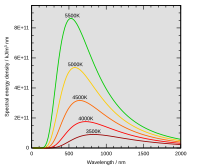
Photo from wikipedia
Abstract Context Cover crops are sown in autumn after harvest of a main crop to capture residual nitrogen and to build biomass that will contribute to soil organic matter after… Click to show full abstract
Abstract Context Cover crops are sown in autumn after harvest of a main crop to capture residual nitrogen and to build biomass that will contribute to soil organic matter after being ploughed under. Mixtures are purportedly more productive than pure stands of single species. Research problem Dry matter accumulation in field crops can be separated in the processes of resource capture and resource conversion. Here we apply this conceptual approach to analyse whether and how pure stands of single species and stands of species mixtures differ in radiation capture and radiation use efficiency. Methods cover crops were sown as pure stands (12 treatments) or mixtures (11 treatments) at two years in four sites, three in the Netherlands and one in northern Germany. Ground cover was measured throughout a growing period of up to twelve weeks to quantify radiation capture while final biomass was determined at harvest. The ratio of biomass and cumulative radiation capture was used to calculate radiation use efficiency. Results Oats and crucifers were the most productive species. Crucifers covered the soil quickly and their radiation capture was consequently high (517 MJ m−2) but their radiation use efficiency was low (0.80 g MJ-1). Oats intercepted less radiation (459 MJ m−2) than crucifers but had a higher radiation use efficiency (1.15 g MJ-1). Legumes had low radiation interception (332 MJ m−2) combined with low radiation use efficiency (0.64 MJ m−2) while the group of forb species belonging to other plant families (e.g. Linaceae, Boraginaceae and Asteraceae) had intermediate radiation capture (371 MJ m−2) and radiation use efficiency (0.84 g MJ-1). The radiation capture and radiation use efficiency of mixtures was similar to that of the dominant species in the mixtures, in all cases a crucifer or oats. Conclusions and implications The analysis of radiation capture and radiation use efficiency in this study indicates that mixture performance was governed by species dominance within the mixture, with the species capturing most of the light determining to a large extent the radiation use efficiency of the mixture as a whole. Results show the importance of including one or more productive species in a species mixture used for cover cropping, i.e. oats or a crucifer. If species with slow initial growth or low radiation use efficiency are included in a mixture to provide particular services, such as flower resources, atmospheric nitrogen fixation or antibiosis against pests, these species should be included in a large enough proportion to enable their establishment in the mixture.
Journal Title: Field Crops Research
Year Published: 2021
Link to full text (if available)
Share on Social Media: Sign Up to like & get
recommendations!